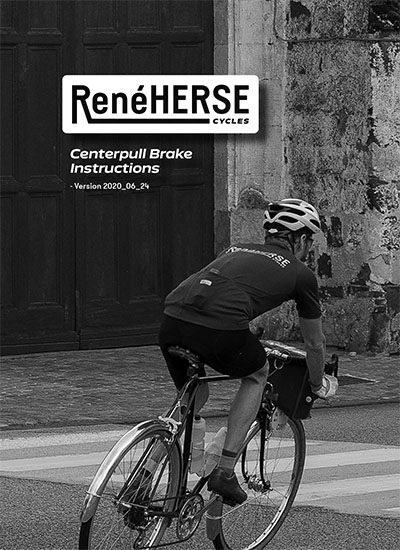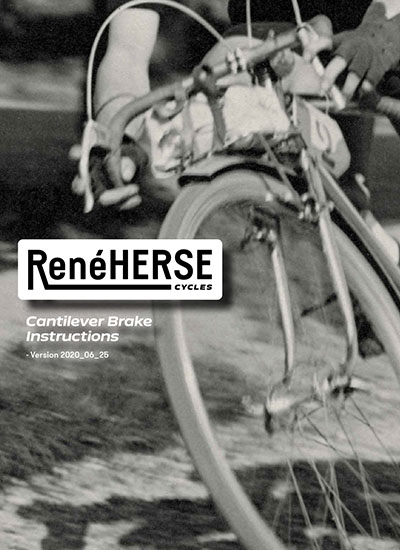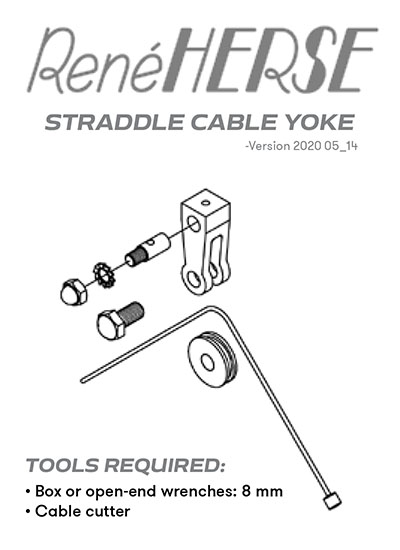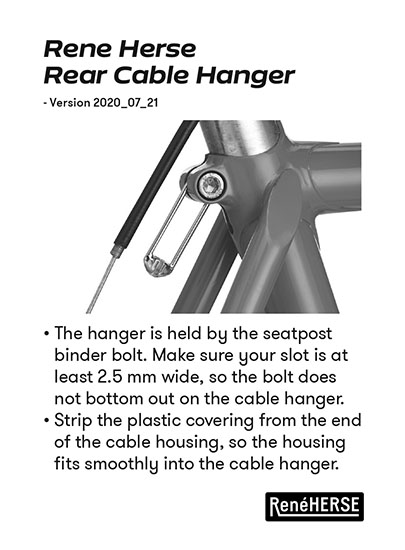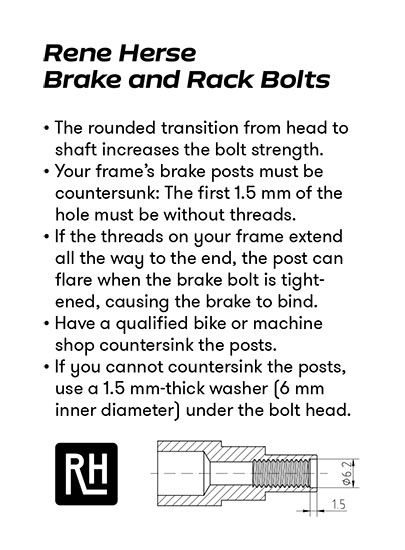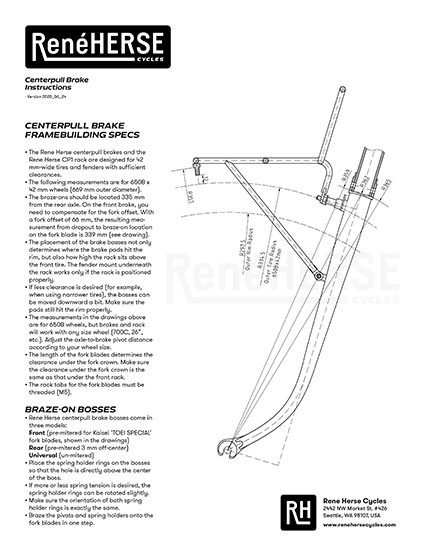Brakes
Instructions
Click on the link below to download instructions (pdf format).
More Information
Do Rene Herse centerpull brakes fit on the posts for other brakes?
The post location of Rene Herse centerpull brakes is specific to our brakes. Rene Herse centerpull brakes don’t fit on the posts for cantilever brakes. They also don’t fit on the posts for centerpull brakes from other makers – with the exception of classic Mafac Raid brakes, which have a similar geometry and post dimensions.
Are Rene Herse cantilever brakes interchangeable with other cantis?
Yes, since the 1970s, cantilever brakes – and V-brakes – use the same post dimensions and placement. In most cases, you can replace your existing cantis or V-brakes with Rene Herse cantilevers.
Pad Wear Adjustment
To adjust for brake pad wear, simply loosen the eyebolts that attach the brake pads and slide them closer to the rim. (During the initial setup, set the pads close to the brake to allow for this adjustment – see the instructions for the brake above.)
We don’t recommend installing barrel adjusters for adjusting pad wear. When the pads wear, they hit the rim in a different location. On centerpull brakes, the pad hits the rim higher, so the pad can cut into the tire and cause a blowout. On cantilevers, the pad hits the rim lower and can ‘dive’ under the rim, resulting in a total loss of braking. Thus, the pad angle needs to be adjusted when the pads wear. This is easily done with the post-style pads used on Rene Herse brakes.
Barrel adjusters also introduce flex into the braking system, which negatively affects the brake’s power and feel.
Pad Replacement
To replace the brake pads of Rene Herse brakes, remove the pad holders. Insert a medium-sized screw driver at the open end of the pad holder, between pad and holder. Lever the pad out of the holder. Slide in a new pad. Use a rubber mallet or a vise to press the pad into the holder, while pushing down onto the pad to make sure it sits at the bottom of the groove in the pad holder. Use a piece of wood to protect the polished finish of the pad holder.
Straddle Cable Length
Many cyclists have heard that a shorter (lower) straddle cable improves the mechanical advantage of cantilever brakes. This is true only for short-reach cantilevers, but not for long-reach cantis and centerpull brakes. For all Rene Herse brakes, straddle cable length has little effect on the mechanical advantage.
With Rene Herse centerpull brakes, make sure that the straddle cables clear your racks and that the yokes don’t obstruct your lights.
The straddle cable of Rene Herse cantilevers is pre-set for optimum braking and tire clearance. For small frames, a shorter straddle cable is available. Longer straddle cables are also available.
Brake Squeal (new brake)
If your Rene Herse brakes squeal when they are new, it’s usually because the toe-in of the pads needs to be increased. Use the angled washer (marked with a dot) under the brake pad, or gently bend the brake arms.
Brake Squeal (appears over time)
If your brakes were silent at first, but start squealing after a while, it’s usually because the toe-in has disappeared as the brake pads have worn. The easiest solution is to turn the pads in their holders: Remove the brake pads from their holders (see above) and insert them in the opposite direction. (DO NOT just turn around the brake pad holders! The open end of the pad holders must be facing toward the rear of the bike, otherwise, the pads can eject during hard braking.)
Uneven Spring Tension
If your Rene Herse brakes don’t retract equally on both sides, first check that the brake arms rotate freely on their pivots. If one or both posts are binding, then the springs will not pull them straight. If you aren’t sure how to match your brake to your posts, check our article in Bicycle Quarterly 68 for detailed instructions. If your bike’s cantilever posts have multiple holes, check that the springs are in the same position on both sides. Usually, one of these solves the problem. If not, contact us via our warranty form.


